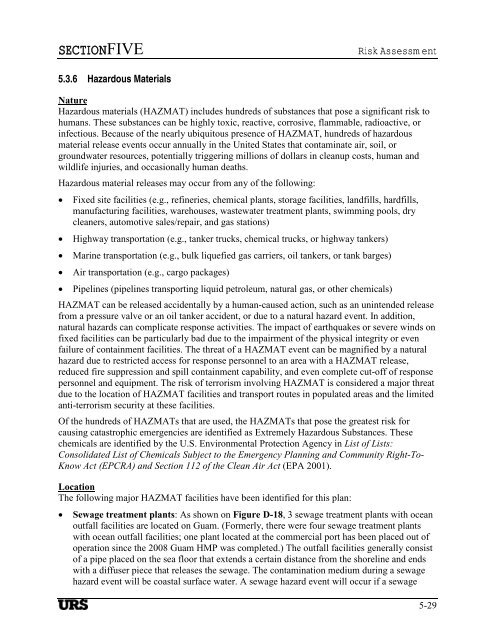Guam Hazard Mitigation Plan - Western States Seismic Policy Council
Guam Hazard Mitigation Plan - Western States Seismic Policy Council
Guam Hazard Mitigation Plan - Western States Seismic Policy Council
Create successful ePaper yourself
Turn your PDF publications into a flip-book with our unique Google optimized e-Paper software.
SECTIONFIVERisk Assessment5.3.6 <strong>Hazard</strong>ous MaterialsNature<strong>Hazard</strong>ous materials (HAZMAT) includes hundreds of substances that pose a significant risk tohumans. These substances can be highly toxic, reactive, corrosive, flammable, radioactive, orinfectious. Because of the nearly ubiquitous presence of HAZMAT, hundreds of hazardousmaterial release events occur annually in the United <strong>States</strong> that contaminate air, soil, orgroundwater resources, potentially triggering millions of dollars in cleanup costs, human andwildlife injuries, and occasionally human deaths.<strong>Hazard</strong>ous material releases may occur from any of the following:• Fixed site facilities (e.g., refineries, chemical plants, storage facilities, landfills, hardfills,manufacturing facilities, warehouses, wastewater treatment plants, swimming pools, drycleaners, automotive sales/repair, and gas stations)• Highway transportation (e.g., tanker trucks, chemical trucks, or highway tankers)• Marine transportation (e.g., bulk liquefied gas carriers, oil tankers, or tank barges)• Air transportation (e.g., cargo packages)• Pipelines (pipelines transporting liquid petroleum, natural gas, or other chemicals)HAZMAT can be released accidentally by a human-caused action, such as an unintended releasefrom a pressure valve or an oil tanker accident, or due to a natural hazard event. In addition,natural hazards can complicate response activities. The impact of earthquakes or severe winds onfixed facilities can be particularly bad due to the impairment of the physical integrity or evenfailure of containment facilities. The threat of a HAZMAT event can be magnified by a naturalhazard due to restricted access for response personnel to an area with a HAZMAT release,reduced fire suppression and spill containment capability, and even complete cut-off of responsepersonnel and equipment. The risk of terrorism involving HAZMAT is considered a major threatdue to the location of HAZMAT facilities and transport routes in populated areas and the limitedanti-terrorism security at these facilities.Of the hundreds of HAZMATs that are used, the HAZMATs that pose the greatest risk forcausing catastrophic emergencies are identified as Extremely <strong>Hazard</strong>ous Substances. Thesechemicals are identified by the U.S. Environmental Protection Agency in List of Lists:Consolidated List of Chemicals Subject to the Emergency <strong>Plan</strong>ning and Community Right-To-Know Act (EPCRA) and Section 112 of the Clean Air Act (EPA 2001).LocationThe following major HAZMAT facilities have been identified for this plan:• Sewage treatment plants: As shown on Figure D-18, 3 sewage treatment plants with oceanoutfall facilities are located on <strong>Guam</strong>. (Formerly, there were four sewage treatment plantswith ocean outfall facilities; one plant located at the commercial port has been placed out ofoperation since the 2008 <strong>Guam</strong> HMP was completed.) The outfall facilities generally consistof a pipe placed on the sea floor that extends a certain distance from the shoreline and endswith a diffuser piece that releases the sewage. The contamination medium during a sewagehazard event will be coastal surface water. A sewage hazard event will occur if a sewage5-29




